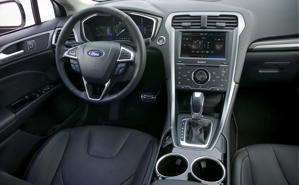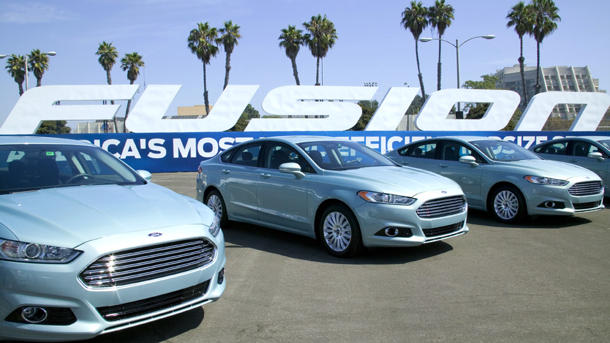For nearly two decades, Honda and Toyota have reigned supreme among midsize sedans -- America's most popular car style, with 2 million sold every year -- with the Honda Accord and Toyota Camry. That is, until last year, when the Nissan Altima and the Ford Fusion surpassed the Accord, and the upstart Hyundai Sonata came close to lapping it as well. This year, Honda, Nissan and Chevrolet have all introduced new versions of their models, but none have been quite as ambitious as Ford's full assault with the 2013 Ford Fusion, a bid to win rather than just show up.
Based on a new platform Ford will build worldwide, the 2013 Ford Fusion rides on front McPherson-strut and rear multi-link suspensions. Compared to the outgoing model, the new Fusion's rear multi-link has been revised to improve ride quality, while keeping the car's overall European-inspired handling characteristics. Much of that on-road responsiveness is thanks to Ford's electric power-assisted steering, one of the best in the industry, providing a confident weighting and progressive effort while dampening the excessive feedback from tortured roads.
At the front, the Fusion adopts the new corporate Ford look, a trapezoidal grille that may remind some of an Aston Martin, a brand Ford once owned. The narrow wrap-around headlights and a character line that runs all the way to the back LED tail lamps is a nice touch to break up the high shoulder profile. Inside, the dash and the center console is simple yet functional. The higher trim levels offer far better quality materials than those in the base models. And in the dash rests a more simplified MyFord Touch system, the oft-criticized entertainment touchscreen.

For power, Ford offers a menu of three 4-cylinder gasoline engines to choose from: a 175-bhp 2.5-liter, a 178-bhp 1.6-liter EcoBoost turbo, and a 240-bhp 2.0-liter EcoBoost turbo. All put the power through a six-speed automatic transmission; a handful of shoppers can buy the 1.6-liter with a 6-speed manual, and the 2.0-liter can be ordered with an all-wheel-drive system. In addition, Ford revamps the Fusion Hybrid with a 2.0-liter inline-4 and an electric motor good in total for 188 hp. Fitted with a continuously variable transmission, EPA rates the Fusion Hybrid at 47 mpg city, 47 mpg highway, and 47 mpg combined -- outrunning the Toyota Camry Hybrid by at least 4 mpg in city and 5 mpg in highway.
In a brief back-to-back drive of the Fusion and Camry hybrids, the Toyota's 200 net hp showed its worth, making the Camry about 0.5 second faster to 60 mph compared to Ford's 8.5 second time. And while the Fusion's CVT whine was minimized, it wasn't as responsive and crisp as the Camry's conventional 6-speed automatic transmission. But the Fusion's overall styling and supple ride quality easily bested the Camry.
On the road, the deluxe 240-hp Ford Fusion Titanium AWD provided comfortable cruising manners and spirited agility when called for. Surprisingly, the optional leather sports seats offer great side bolster and lumbar support for just cruising around town or tackling curvy roads. The available paddle shifters behind the steering wheel allow you to quickly call up a lower gear when you are eager to accelerate off the corners quickly. For zero to 60 mph sprints, the new Fusion can clock in at around 6.9 sec., nearly one second faster than the 182-hp Nissan Altima S.
As much as the new Fusion aims for the front of the pack, Ford will need to check its rearview mirrors as well. The Hyundai Sonata and Kia Optima have also evolved quickly -- not only in quality, reliability and performance, but also something that is even harder to get right; the emotional connection with customers that's very difficult, if not nearly impossible, to engineer. Until then, it's enough to say that against the powerhouses of the midsize sedan world, the new Fusion stacks up well.
source
